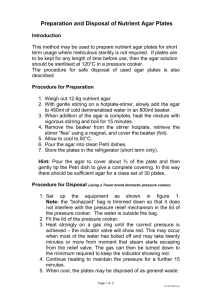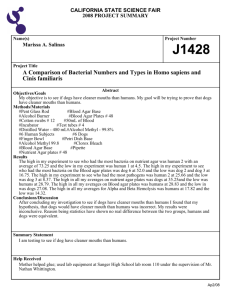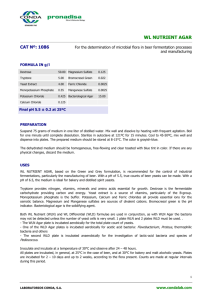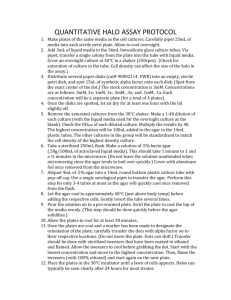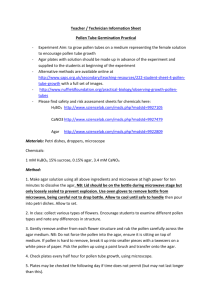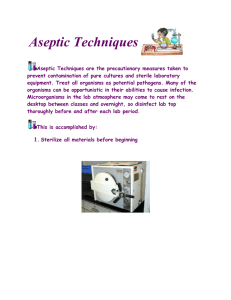SOP: Preparing agar plates
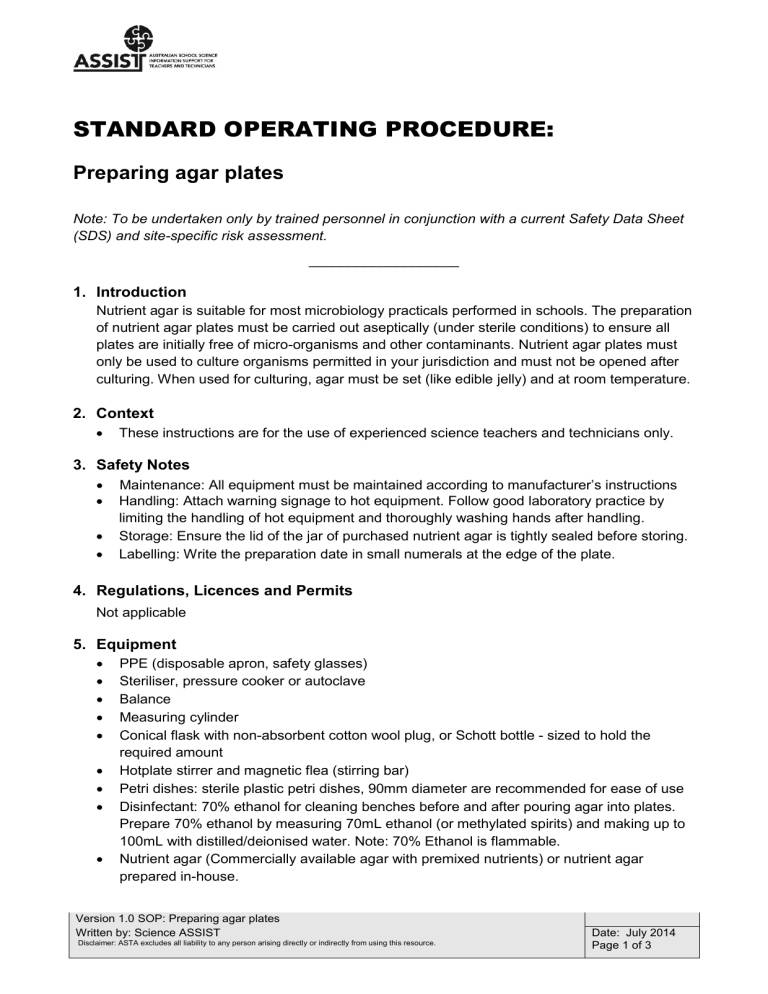
STANDARD OPERATING PROCEDURE:
Preparing agar plates
Note: To be undertaken only by trained personnel in conjunction with a current Safety Data Sheet
(SDS) and site-specific risk assessment.
___________________
1. Introduction
Nutrient agar is suitable for most microbiology practicals performed in schools. The preparation of nutrient agar plates must be carried out aseptically (under sterile conditions) to ensure all plates are initially free of micro-organisms and other contaminants. Nutrient agar plates must only be used to culture organisms permitted in your jurisdiction and must not be opened after culturing. When used for culturing, agar must be set (like edible jelly) and at room temperature.
2. Context
These instructions are for the use of experienced science teachers and technicians only.
3. Safety Notes
Maintenance: All equipment must be maintained according to manufacturer’s instructions
Handling: Attach warning signage to hot equipment. Follow good laboratory practice by limiting the handling of hot equipment and thoroughly washing hands after handling.
Storage: Ensure the lid of the jar of purchased nutrient agar is tightly sealed before storing.
Labelling: Write the preparation date in small numerals at the edge of the plate.
4. Regulations, Licences and Permits
Not applicable
5. Equipment
PPE (disposable apron, safety glasses)
Steriliser, pressure cooker or autoclave
Balance
Measuring cylinder
Conical flask with non-absorbent cotton wool plug, or Schott bottle - sized to hold the required amount
Hotplate stirrer and magnetic flea (stirring bar)
Petri dishes: sterile plastic petri dishes, 90mm diameter are recommended for ease of use
Disinfectant: 70% ethanol for cleaning benches before and after pouring agar into plates.
Prepare 70% ethanol by measuring 70mL ethanol (or methylated spirits) and making up to
100mL with distilled/deionised water. Note: 70% Ethanol is flammable.
Nutrient agar (Commercially available agar with premixed nutrients) or nutrient agar prepared in-house.
Version 1.0 SOP: Preparing agar plates
Written by: Science ASSIST
Disclaimer: ASTA excludes all liability to any person arising directly or indirectly from using this resource.
Date: July 2014
Page 1 of 3
6. Operating Procedure
To make 1 litre, sufficient for approximately 50-60 plates.
1. Using a digital balance, prepare the agar medium a ccording to the manufacturer’s instructions. Alternatively prepare in-house:
Beef extract or ground up stock cubes 5-10g
Peptone of a yeast extract 5-10g
Agar 15g
Distilled water 1L
2. Place water in a 1 litre beaker. Using the hotplate stirrer and magnetic stirring bar, mix ingredients with the water whilst stirring to prevent clumping. Heat whilst stirring until the agar dissolves at 95 0 C. The agar is then poured into conical flasks and plugged with non absorbent cottonwool, or into Schott bottles filled no further than 2/3. The lid of the Schott bottle is to be closed fully, then released ¼ turn prior to sterilising.
3. Sterilize the conical flask or Schott bottle using a pressure cooker or autoclave 20 minutes at 121 0 C, 15psi, according to manufacturer’s instructions for use of this equipment.
4. The pressure in the vessel should be at zero prior to opening the equipment.
The sterilized agar is allowed to cool to 50 0 C – 55 0 C, this is the optimal temperature for pouring to minimise condensation. It might be useful to sit the flask or bottle in a water bath at this temperature to maintain the optimal temperature prior to pouring plates. Agar solidifies at 42 o C.
5. Thoroughly wash and dry hands, wear a disposable apron.
6. Create a sterile area by thoroughly wiping the bench with 70% alcohol and paper towel.
Do not completely dry the ethanol, allow it to evaporate. Air conditioners, fans and fume cupboards must be turned off, windows and doors closed and foot traffic restricted, to reduce the chance of contamination to plates while pouring.
7. Label the sterile Petri dishes and organise them base down (the smaller section of the two halves) on the bench.
8. Hold the flask containing sterile agar medium in liquid form with your right hand. Turn your left hand palm side up and clamp the cotton plug between two fingers.
9. Use the hand holding cotton plug to lift the lid of the Petri dish. Pour approximately 15 to
20mL of the sterilised nutrient agar medium into the base of the Petri dish, until it is about half full. Hold the petri dish lid so that it partially covers the bottom of the dish as you pour.
This prevents microbes and air borne dust particles from dropping into the sterile plate and contaminating it.
10. Immediately place the lid on the base at an angle so that steam is able to escape.
11. Pour the remaining plates the same way.
12. Allow the plates to cool to room temperature for approximately 30 minutes before packing upside down into labelled plastic bags, or use the bags the plates came in. Refrigerate the plates. Plates can be stored for several weeks prior to use.
13. Disinfect benches using 70% Ethanol on completion.
Version 1.0 SOP: Preparing agar plates
Written by: Science ASSIST
Disclaimer: ASTA excludes all liability to any person arising directly or indirectly from using this resource.
Date: July 2014
Page 2 of 3
7. Trouble shooting/Emergencies
First Aid: See latest SDS for more detailed information o If swallowed: Do not induce vomiting. Rinse mouth with water, and then give water to drink. Seek medical attention. o If in eyes: Hold open and irrigate with copious quantity of water. Seek medical attention. o If on skin or hair: Flush skin and hair with running water (and soap if available). Seek medical attention if irritation occurs.
Condensation of nutrient agar plates occurs when steam is trapped inside the plate when the lid has been fully replaced on the dish when the agar is too hot. Allow agar to cool to
50 0 C – 55 0 C before pouring.
Agar not setting is a result of not using correct amount of agar or of not adequately dissolving the agar prior to sterilising. Check carefully that all solids have dissolved before sterilising.
Contamination is a result of inadequate aseptic technique or contaminated benches or equipment. Review operator aseptic techniques prior to pouring agar plates.
8. Waste Disposal
Cleaning up: All equipment used in the preparation of nutrient agar is to be washed thoroughly in warm soapy water, rinsed and dried.
All nutrient agar plates, including plates not cultured, must be sterilised/autoclaved prior to being placed in double plastic garbage bag and sealed for immediate disposal in the industrial bins
9. Related Material
Manufacturer’s Safety Data Sheets
Risk Assessment.
Manufacturer ’s instructions for pressure cooker/ autoclave
References:
Chemwatch Gold. 2012. Long Safety Data Sheet: Nutrient Agar . http://www.chemwatch.net
(Subscription required accessed March 2014).
Young, J. 2008. The Biolab Sourcebook.
Triple Helix Resources NZ
Version 1.0 SOP: Preparing agar plates
Written by: Science ASSIST
Disclaimer: ASTA excludes all liability to any person arising directly or indirectly from using this resource.
Date: July 2014
Page 3 of 3


